14 Creative Activities that Have Brought Us Joy and Understanding
Creative Activities that Have Brought Us Joy and Understanding
As we created this journal, we respect that some crafts and art activities we encourage you to consider take time, funds, and space. We watched for and obtain journal books, art and craft supplies at thrift stores, recycle depots, and watch for items on sale. Some supplies came, or come, from family and friends who yearn for us to be healthy, and therefore gift us creative kits or supplies to work with and heal. We know from our collective experiences that alongside our active journaling our creative works bring us understanding around our experiences with an eating disorder. Through this journal, we have focused on sharing our own creative works to encourage you.
In eating disorder treatment, group activities may be part of treatment. These group activities may take place in clinics, hospitals, online, and in the community. For example, in an inpatient program, you may attend creative classes one or two times a week for 45 to 60 minutes. An occupational therapist, recreation therapist, or art therapist (there may be others) may ask the group to create art in relation to perceptions of our body. This can be followed by a rich conversation about growing in healthy ways and self-care. In another program based in the community, an eating disorder therapist may encourage you to take drawing or painting classes at the local community center. Participating in creative activities alone, in a group, or with a friend alongside deeply influenced our understanding of our relationship to our thoughts, feelings, and life choices. We each learned to keep creative supplies with us and around us. For example, begin by carrying a sketchbook and begin to sketch and doodle at a local beach, park, or on breaks at work.
As we created this journal, we poured through our memories and journals to identify what activities brought healing and understanding to our eating disorder. We have listed below some of the creative activities that drew us toward health and to sustain wellness today. This list is not all-inclusive. The following list describes some of the activities that helped us along the way:
Creating Art with Found Objects
Janet shares: As a learner in an art therapy program (Canadian International Institute of Art Therapy, 2022), I learned that creating art using ‘found objects’ was an actual type of creativity. Here are the steps to creating art with found objects.
Step 1: Locate the objects. Stand in your home living space and collect 20 or 30 objects that you think you could use to create an image. For example, here is what I collected from a couple of drawers in the kitchen: string, elastics, bread tags, old keys, colored napkins, rope, foam packing, cardboard, plain paper, cards, labels, paper bags, glue, needles, scissors, acrylic paints, and thread.
Step 2: Sit quietly, put on some music, and begin to play – during this time I made a cup of herb tea, but you can do anything you wish!
Step 3: Think about your breathing, the depth of each breath, and how you are feeling
Step 4: Begin to create an art piece with the objects. Take your time. Remember creating is about the time it takes to create not about the outcome.
Step 5: Reflect on your creation. What was your breathing like during this activity. What do you think of your creation?
The following is an example of what Janet created:
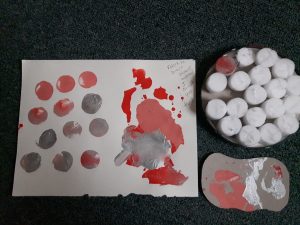
Create Your Own “Found Objects’ Book for Personal Journaling
In this activity you will see similarities to creating art with found objects. To create your own book for journaling you begin with a book (I got mine at the thrift store) that you want to redesign and recreate to be used for your journaling. Here are the following steps:
Step 1: Find a book (any type) that you want to recreate or redesign to your liking. Here is the outside cover of my book, I added a card from my dear friend’s garden – An Angel. I used thick cardboard from a perfume box to make a new title for my book
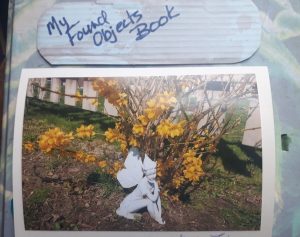
Image description: picture of Janet’s friend’s garden, which includes a statue of a sitting angel.
Step 2: Collect any objects, cards, stickers, feathers, rope, string, elastics, napkins, and coloured cardboard – I love to use the linings and boxes that tea is packaged within.
Step 3: Take time and begin to redesign your book. Paste and add found objects on each page inside the book. This took me a couple of weeks. Each time I found a new object I added it to the book.
Step 4: Gift the book to yourself for a journal.
Step 5: Pay attention to how creating makes you think and feel. What was it like to sit quietly and create? Did you play music? Did you find quietness and peace during this time? Here are two pages of Janet’s book; she kept her first found object book and continued to add cards and notes from friends. This way she can go and read and enjoy their encouraging notes. Share with a trusted health care clinician.
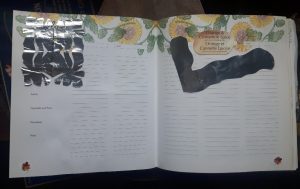
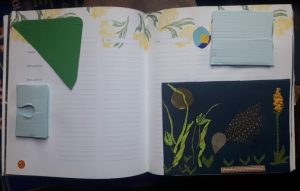
Drawing and Doodling
Janet shares: One of my favorite things to do is to doodle as it helps me to concentrate and focus. As well, in time, my doodles told my story and helped me move from not being able to share to being able to find my voice. Here are the steps to doodling:
Step 1: Decide on the paper and crayons, pencils, or pens you will use. Some times I just sit and make 1000’s of squiggly lines with 50 colours to see what emerges. In relation to body size and shape and my perception of myself at times here is an example of doodling and my perceptions
Step 2: Draw a mirror, any size or shape will work. Here I have drawn a tall mirror.
Step 3: Draw how you see your body. I have not drawn myself reflected in the mirror and during this time of drawing I felt to distorted to be seen in the mirror. “Today, I feel many heavy, hot layers of my body and in this size I feel safe and hidden from the harms of the outside world” Janet.
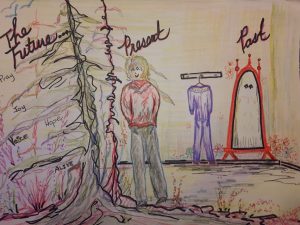
Image description: a sketch from Janet depicting her perceived past present and future of her body.
Janet thinks more: “In reality and with good people alongside I know generally know myself as capable (Brene Brown, 2016) and I dare greatly every day, well most days I feel like the person in the arena” (Roosevelt, as cited in Brown, 2016).
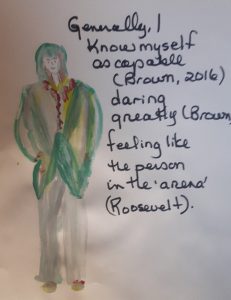
Step 4: How was the process of doodling for you? Did you challenge yourself to draw a mirror? Do you see yourself reflected in the mirror? What do you think and feel when you reflect on your drawn body? Did you add colours to your creation, and does this have any meaning to you? Share with a trusted clinician.
Photos on My Camera
Hannah shares: “We are all trying to capture the perfect picture. Some days it seems impossible. We find flaws in ourselves and the world around us. However, if we stop to enjoy the experience, we might find time to capture the beauty that exists.”
Photos may be of yourself, including selfies captured during moments of happiness, or tears. They may also be of nature, family, pets, food, or things you have created. Photos reflect what we see. We capture moments in time. You can then create galleries of pictures or collages of photos. You can print them off or create digital photobooks.
“I have 10,000 pictures on my phone. Each one carries a memory of my life. I stop and reflect on the emotion and the memory that is tied to a photo. Thus, my phone carries my hopes, dreams, heartaches, and joy.” Hannah
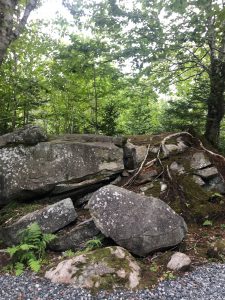
Most of us use our phones to capture photos but we also have the ability to capture video. This is a great way to capture moments in real-time. Videos can be uploaded to various media platforms, including YouTube and TikTok, or kept private for your viewing only.
Sewing and Stitching
Janet shares: Collecting fabric, buttons and lace and then creating a pillow or piece of art brings joy. It is the time collecting bits and pieces from friends, family, craft or thrift stores that offers time to think and be. Sometimes it is the trip to the material store with a friend. It is the time laying out and slowly hand stitching the bits and pieces of lace and fabric into a story. The quiet time slowing brings joy.
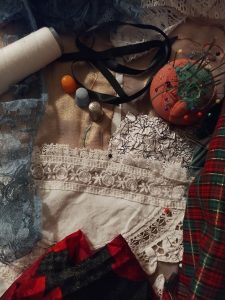
Image description: a picture of a collection of sewing items
Painting
Janet shares: “Painting can be done with many creative mediums. Water colours, chalk with water brushed over it, acrylic paints with water added to make many shades, and oil paint come to mind. Take a walk in your local craft stores to see the rich array of colors and products available. I started painting on hard boards, the sides of orange boxes, the back of wallpaper, cardboard (many types and thicknesses), and now papers prepared for each type of paint. In time, I began to focus on how I felt while I was sitting and painting. I learned that I was so focused on the end picture that I was not always enjoying painting. I know to take my time, put on my music, sit quietly, and then begin the painting.”
I make cards to give to friends and family, paintings to put on my fridge (the child in me) and for fun. As well, I love to paint old objects to refresh them and bring joy through color. I find it to be a healthy distraction from some of the events and stressors in life.

Mask Making
Janet shares: “This was a new activity to me this year taught to me by experienced teachers (CiiAT, 2022). One of the things we have learned is that when living with an eating disorder, we have masks. We have the mask we put on at work, at play, and when living in general. We often look okay, yet feel unwell inside. In this exercise, the person creates a mask from any supplies around you. Then on the inside of the mask, you write yourself a love letter, reflecting who you are now, and who you want to become or are becoming.”
Step 1: Find a sheet of paper and tape it into a mask shape
Step 2: Use all your found objects to color and decorate your mask focusing on how you feel on the outside. This took me about a week as I waited for the glue to dry (Janet).
Step 3: Write a love note to yourself about who you are now, who you want to be and who you are becoming as you heal
Step 4: Tape this note inside the mask.
Step 5: Display your mask. Reflect and journal on what it felt like to explore this part of your life. Share your mask and journal with a trusted healthcare clinician.
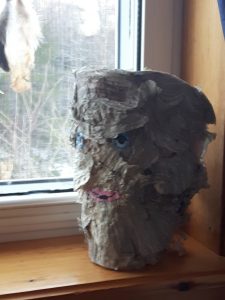
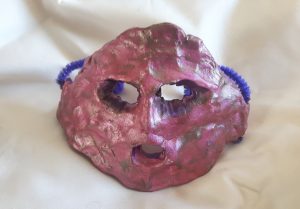
Walking in Nature
Janet shares: “By a local creek I stood in the sand. I bent slowly feeling the cold water rush by. Using my phone I take photos, I also feel the cold water on my boots.”
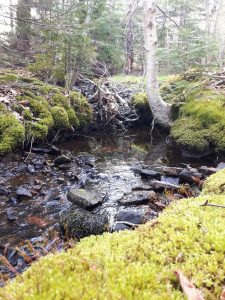
Image description: a photo of a creek in the forest.
Boxes Hold Memories and Treasures
Janet shares: “In a recent art class we made boxes from objects around us. These may be recycled or re-purposed boxes that you color, paint or decorate with your favorite fabrics, foils, bark, or moss. This exercise may be done to create space for treasured places to hold objects dear to our hearts.”
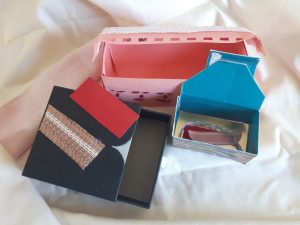
Music Matters in All Forms: Do you prefer to listen to music, create music, sing, hum, whistle or write music. All are creative forms that bring us creative space.
Janet shares: “In the last years, I learned to play ukulele by attending classes in a small village and following a teaching book. I then moved to play the banjo/ukulele = banjolele. This is my favorite instrument, I try to play 10 to 20 minutes a day.”- Janet
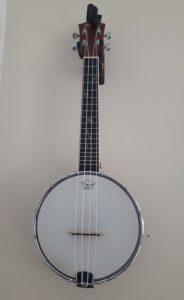
Working in Clay
Janet shares: “I love the cool touch of the grey/white coloured clay. I bought clay from the local craft store and followed the product instructions. I enjoyed the small pots and bowls I created. I use them about the house. Clay creations are done in stages. Create your piece, re-work the piece, drying, painting, re-painting, drying, and enjoying.”
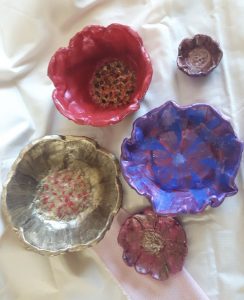
Image description: a photo of handmade clay bowls
These are a few of the arts and crafts we enjoy and wanted to share. We hope you too find a way of expressing yourself that nurtures you, and helps you bring joy and hope into your life. Creating is not just about the end product, it is about how you think, feel and behave while you are creating. Remember, you are important.

